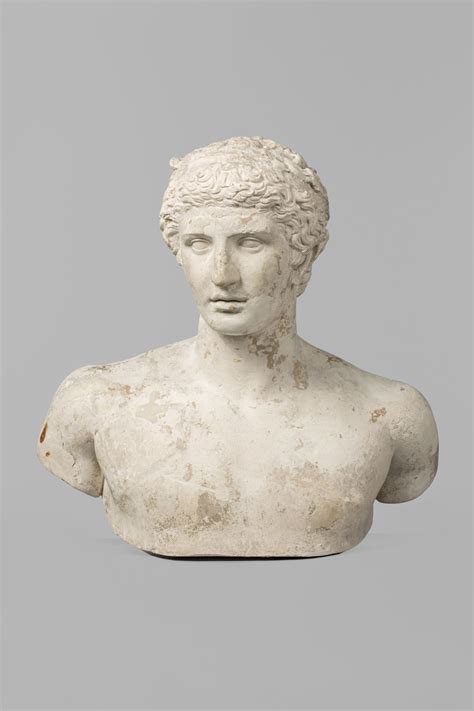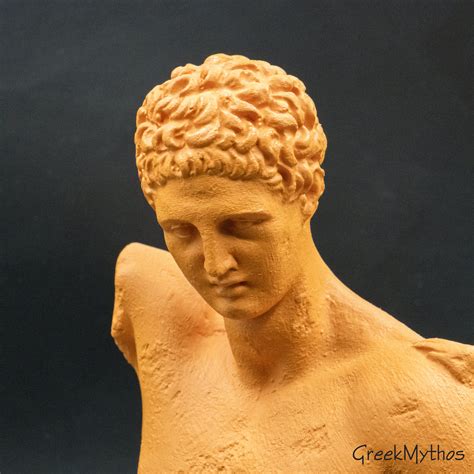hermes and the infant dionysos analysis | the death of laocoon and his sons hermes and the infant dionysos analysis Hermes and Dionysus: In Greek mythology, Hermes is the messenger of the gods, and Dionysus is the god of wine, fertility, and ecstasy. The mythological narrative depicted here shows Hermes protecting the infant Dionysus from the wrath of Hera, highlighting themes of protection and . $49.00
0 · torso of hermes after polykleitos
1 · the god hermes by praxiteles
2 · the death of laocoon and his sons
3 · hermes by praxiteles
4 · hermes bearing the infant dionysus
5 · hellenistic statue of hermes
6 · dionysus and hermes relationship
7 · aphrodite of knidos by praxiteles
$112.00
torso of hermes after polykleitos
Hermes and Dionysus: In Greek mythology, Hermes is the messenger of the gods, and Dionysus is the god of wine, fertility, and ecstasy. The mythological narrative depicted here shows Hermes protecting the infant Dionysus from the wrath of Hera, highlighting themes of protection and . The statue of Hermes and the Infant Dionysus, supposedly created by Praxiteles, was discovered on May 8, 1877, but its influential presence makes it a timeless piece of Hellenism, and later, Western culture. It is seen as the .Hermes and the Infant Dionysus, also known as the Hermes of Praxiteles or the Hermes of Olympia is an ancient Greek sculpture of Hermes and the infant Dionysus discovered in 1877 in the ruins of the Temple of Hera, Olympia, in Greece. It is displayed at the Archaeological Museum of Olympia. It is traditionally attributed to Praxiteles and dated to the 4th century BC, based on a remark by th.According to myth, Hermes and Dionysos were sons of Zeus, but by different mothers (the princess Semele and the minor goddess Maia, respectively). To protect the infant Dionysos, .
The portrayal of Hermes holding the infant Dionysus highlights the importance of familial bonds among gods in Greek mythology. This connection illustrates Hermes' role as a guide and . This masterpiece of the classical era stands as an epitome of grace, showcasing the divine messenger and son of Zeus, Hermes, holding the infant Dionysus, the god of wine. .
gucci zonnebril sale
Greek sculpture. In Western sculpture: Late Classical period (c. 400–323 bce) The Hermes Carrying the Infant Dionysus at Olympia, which may be an original from his hand, gives an .Hermes and the Infant Dionysus, also known as the Hermes of Praxiteles or the Hermes of Olympia is an ancient Greek sculpture of Hermes and the infant Dionysus discovered in 1877 . Zeus took Semele's baby, Dionysus, and nurtured him until he was ready to be born. Once he was born, Zeus gave Dionysus to Hermes to protect the baby from Zeus' wife, . This statue was uncovered during excavations in 1877 at the Temple of Hera at Olympia. The statue captures the myth where Hermes takes the baby Dionysos to the .

The myth depicted, I believe, is Hermes bringing the infant Dionysos to King Athamas and Ino, one of the mythological versions of Dionysos' childhood3. Zeus, who retrieved the un-born fetus of Dionysos from Semele before her death by thun-derbolt, placed the fetus in his thigh in order to protect it from the jealousy of Hera. What: Hermes and the Infant Dionysus (also known as Hermes of Praxiteles or Hermes of Olympia) Artist: Praxiteles Type: Sculpture Year: Fourth century BC Medium: Parian Marble Subject: Hermes holding Dionysus Where: Archaeological Museum of Olympia Why: I like this work for its historical values. I often ask myself: what does any specific artwork tell.
Hermes strides to the right, holding the infant Dionysos. Hermes wears a petosos (his three-cornered hat) and flowing chlamys. Dionysos is wrapped in a folded garment. Commentary The subject of Dionysos's childhood was popular during the late Hellenistic-early Roman period. The classicizing and graceful figures seen here are characteristic of . This statue was uncovered during excavations in 1877 at the Temple of Hera at Olympia.The statue captures the myth where Hermes takes the baby Dionysos to the Nymphs, where on his way he rests upon a tree trunk, having thrown his cloak over it. It is suggested that the right hand may have held some grapes, associated with the god of wine, Dionysos. The .Hermes and the Infant Dionysus by Praxiteles From the temple of Hera, Olympia c. 330 B.C. Museum, Olympia This Hermes of Praxiteles captures the contained and thoughtful spirit of the fourth century. Hugh Lester, Tulane UniversityHermes measures 2.10/2.12 m, 3.70 m with the base. The right foot of Hermes is integral with a section of the base, which has undergone some adjustment in antiquity. The face and torso of Hermes are striking for their highly polished, glowing surface, which John Boardman half-jokingly attributed to generations of female temple workers.
The Classical restraint and poise is replaced by an undulating body in a defined S-curve which defies equilibrium. While the proportions of the infant Dionysus are not quite lifelike, the inclusion of babies/children in Late Classical sculpture is significant of social changes, of the prevailing secularism and sentimentalism from this point on.
In this analysis two ancient Greek sculptures from the same time period will be studied and described. The first sculpture is Hermes and the Infant Dionysus that is often considered to be made by Praxiteles in the 4 th century BC; however, the assumption about its origin is not confirmed. It was found in Olympia and is currently displayed at the Archeological .
Praxiteles: "Hermes with the Young Dionysus". Marble sculpture (c. 340 BC.). Archaeological Museum, Olympia. The statue represents the god Hermes standing in a relaxed pose, holding the infant Dionysus on his arm, and playing with him. Click on image for full size Corel Corporation. Hermes and the Infant Dionysos, Archaeological Museum of Olympia. Hermes and the Infant Dionysus, also known as the Hermes of Praxiteles or the Hermes of Olympia is an ancient Greek sculpture of Hermes and the infant Dionysus discovered in 1877 in the ruins of the Temple of Hera, Olympia, in Greece.It is displayed at the Archaeological Museum of Olympia. .Hermes lacks the lower legs (the right foot is original), the right forearm including the elbow and various small pieces. Dionysos' left shoulder/upper arm and parts of the torso are also restored. Collection History:
the god hermes by praxiteles
This is a damaged cast of the Hermes and the Infant Dionysos excavated from the Heraion at Olympia in 1877 and seen by Pausanias in the 2nd c. CE, who attributed the work to the 4th c. BCE sculptor Praxiteles (5.17.3-4). The statue group represents the period following Dionysos' birth from Zeus' thigh, when the king of the gods handed the .Hermes and the Infant Dionysos Diskobolos, total front left Diskobolos Diskobolos, total front right: PRAXITELES FOLLOWER Hermes and the Infant Dionysos ca 300-250 B.C. attributed by Pausanias 2.15 m high restored left leg below knee from Heraion at Olympia: Last Image
Discovery of Hermes and the Infant Dionysus. The Greek state signed an agreement with Germany in 1874 for archaeological exploration at Olympia. Excavations by a German team began in 1875 under the direction of Ernst Curtius. On May 8, 1877 it was found in the ruins of the same temple of Heraeum where Pausanias saw it.Hermes and Dionysus: In Greek mythology, Hermes is the messenger of the gods, and Dionysus is the god of wine, fertility, and ecstasy. The mythological narrative depicted here shows Hermes protecting the infant Dionysus from the wrath of Hera, highlighting themes of . The statue of Hermes and the Infant Dionysus, supposedly created by Praxiteles, was discovered on May 8, 1877, but its influential presence makes it a timeless piece of Hellenism, and later, Western culture. It is seen as the epitome of .Hermes and the Infant Dionysus, also known as the Hermes of Praxiteles or the Hermes of Olympia is an ancient Greek sculpture of Hermes and the infant Dionysus discovered in 1877 in the ruins of the Temple of Hera, Olympia, in Greece. It is .
According to myth, Hermes and Dionysos were sons of Zeus, but by different mothers (the princess Semele and the minor goddess Maia, respectively). To protect the infant Dionysos, Zeus entrusted him to Hermes, who together with a band of nymphs, hid the child near Mt. Nysa in Anatolia (modern Turkey).The portrayal of Hermes holding the infant Dionysus highlights the importance of familial bonds among gods in Greek mythology. This connection illustrates Hermes' role as a guide and protector, emphasizing themes of nurture and care.
This masterpiece of the classical era stands as an epitome of grace, showcasing the divine messenger and son of Zeus, Hermes, holding the infant Dionysus, the god of wine. Hermes is portrayed as a young, athletic figure with harmonious proportions, embodying the idealized male form of the period.
Greek sculpture. In Western sculpture: Late Classical period (c. 400–323 bce) The Hermes Carrying the Infant Dionysus at Olympia, which may be an original from his hand, gives an idea of how effectively a master could make flesh of marble.Hermes and the Infant Dionysus, also known as the Hermes of Praxiteles or the Hermes of Olympia is an ancient Greek sculpture of Hermes and the infant Dionysus discovered in 1877 in the ruins of the Temple of Hera, Olympia, in Greece. It is .
Zeus took Semele's baby, Dionysus, and nurtured him until he was ready to be born. Once he was born, Zeus gave Dionysus to Hermes to protect the baby from Zeus' wife, who was jealous. Hermes put the baby Dionysus in the care of Io, Semele's sister.
the death of laocoon and his sons
hermes by praxiteles

$49.99
hermes and the infant dionysos analysis|the death of laocoon and his sons




























